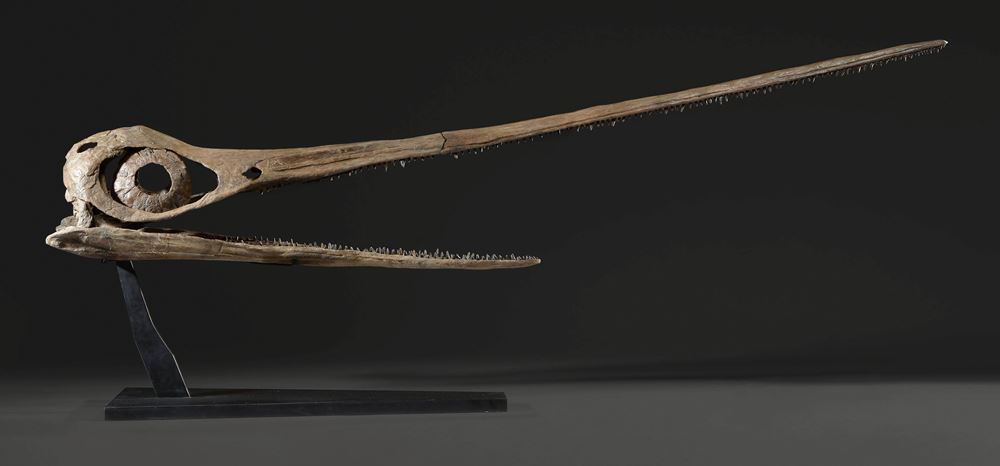
Lot 930* - S18 Out of This World - Dienstag, 18. April 2023, 16.00 Uhr
SCHÄDEL EINES EURHINOSAURUS LONGIROSTRIS
Das grösste jemals entdeckte Exemplar
Mittleres Toarcium, ca. 180 Millionen Jahre
Holzmaden, Deutschland
227 × 45 cm
Mittleres Toarcium, ca. 180 Millionen Jahre
Holzmaden, Deutschland
227 × 45 cm
Eurhinosaurus (ancient Greek for ‘well-nosed lizard’) is an extinct medium-sized ichthyosaur genus of the Lower Jurassic (Toarcian) period of Europe. Eurhinosaurus first appeared in the Lower Toarcian and was last recorded in the Middle Toarcian, i.e. it lived about 180 million years ago.
Characteristic for the genus Eurhinosaurus is its extreme overbite. The lower jaw is about 60% shorter than the upper jaw. Dr Jürgen Riess (Dresden) assumes that Eurhinosaurus preferred ground-based feeding behaviour and that the long upper snout was a sensory organ which it would have used to track down its prey in the sediment. The synapomorphies also include the quadratojugal in a posterior position and smooth, pointed, narrow teeth. The orbit is remarkably large and round, and is the reason for the greatly reduced cheek region.
The skull presented here is extremely well-preserved. The mandible is almost completely intact with only 5% restoration. The rostrum is complete at 75%. The back of the skull is also very well preserved, with only minor restorations.
This skull was found in a very hard pyritised nodule in Germany. It took no less than ten months of preparation work by two talented palaeontologists to realise this project, resulting in a stunning work of natural art.
This is the largest skull known from this species in the world. We estimate the length of the full animal at over 32 ft (10 m): a true giant of the sea!
Characteristic for the genus Eurhinosaurus is its extreme overbite. The lower jaw is about 60% shorter than the upper jaw. Dr Jürgen Riess (Dresden) assumes that Eurhinosaurus preferred ground-based feeding behaviour and that the long upper snout was a sensory organ which it would have used to track down its prey in the sediment. The synapomorphies also include the quadratojugal in a posterior position and smooth, pointed, narrow teeth. The orbit is remarkably large and round, and is the reason for the greatly reduced cheek region.
The skull presented here is extremely well-preserved. The mandible is almost completely intact with only 5% restoration. The rostrum is complete at 75%. The back of the skull is also very well preserved, with only minor restorations.
This skull was found in a very hard pyritised nodule in Germany. It took no less than ten months of preparation work by two talented palaeontologists to realise this project, resulting in a stunning work of natural art.
This is the largest skull known from this species in the world. We estimate the length of the full animal at over 32 ft (10 m): a true giant of the sea!
CHF 110 000 / 140 000 | (€ 113 400 / 144 330)
Verkauft für CHF 134 500 (inkl. Aufgeld)
Angaben ohne Gewähr


